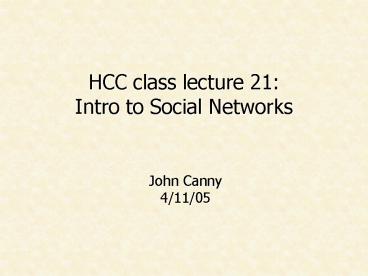HCC class lecture 21: Intro to Social Networks PowerPoint PPT Presentation
1 / 20
Title: HCC class lecture 21: Intro to Social Networks
1
HCC class lecture 21 Intro to Social Networks
John Canny4/11/05
2
Administrivia
- Ill be out next Monday, but class as usual.
3
Social Networks
- A structural approach to understanding social
interaction. - Networks consist of Actors and the Ties between
them. - We represent social networks as graphs whose
vertices are the actors and whose edges are the
ties. - Edges are usually weighted to show the strength
of the tie.
4
Social Networks
- In the simplest networks, an Actor is an
individual person. - A tie might be is acquainted with. Or it might
represent the amount of email exchanged between
persons A and B.
5
Social Network Examples
- Effects of urbanization on individual well-being
- World political and economic system
- Community elite decision-making
- Social support
- Group problem solving
- Diffusion and adoption of innovations
- Belief systems
- Social influence
- Markets
- Sociology of science
- Exchange and power
6
Social Network Examples
- Instant messaging
- Newsgroups
- Co-authorship, Citation, Co-citation
- SocNet software, Friendster
- Blogs and diaries
- Blog quotes and links
7
History
- Sociograms were invented in 1933 by Moreno.
- In a sociogram, the actors are represented as
points in a two-dimensional space. The location
of each actor is significant. E.g. a central
actor is plotted in the center, and others are
placed in concentric rings according to
distance from this actor. - Actors are joined with lines representing ties,
as in a social network. - In other words a social network is a graph, and a
sociogram is a particular 2D embedding of it.
8
History
- These days, sociograms are rarely used (most
examples on the web are not sociograms at all,
but networks). - But methods like MDS (Multi-Dimensional Scaling)
can be used to lay out Actors, given a vector of
attributes about them. - Q What does MDS do?
9
History
- Social Networks were studied early by researchers
in graph theory (Harary et al. 1950s). - Some social network properties can be computed
directly from the graph. - Others depend on an adjacency matrix
representation (Actors index rows and columns of
a matrix, matrix elements represent the tie
strength between them).
10
Social Networks Basic Questions
- What is a group? (or a community of practice)
- Is person X a member of social group Y?
- A clustering or clique-recognition task.
- Related
- Group boundaries
- Are the relations transitive? Friendship, trust
etc.
11
Social Networks Basic Questions
- Balance important in exchange networks
- In a two-person network (dyad), exchange of
goods, services and cash should be balanced. - More generally, exchanges of favors or
support are likely to be quite balanced.
12
Social Networks Basic Questions
- Role what role does the actor perform in the
network? - Role is defined in terms of Actors
neighborhoods. - The neighborhood is the set of ties and actors
connected directly to the current actor. - Actors with similar or identical neighborhoods
are assigned the same role. - What is the related idea from semiotics?
- Paradigm interchangability. Actors with the
same role areinterchangable in the network.
13
Social Networks Basic Questions
- Prestige How important is the actor in the
network? - Related notions are status and centrality.
- Centrality reifies the notion of peripheral vs.
central participation from communities of
practice. - Key notions of centrality were developed in the
1970s, e.g. eigenvalue centrality by Bonacich. - Most of these measures were rediscovered as
quality measures for web pages - Indegree
- Pagerank eigenvalue centrality
- HITS ? two-mode eigenvalue centrality
14
Concepts Actor
- An actor is a basic component for SNs. Actors
can be - Individual people
- Corporations
- Nation-States
- Social groups
15
Concepts Modes
- If all the actors are of the same type, the
network is called a one-mode network. - If there are two groups of actor then it is a
two-mode network. - E.g. an affiliation network is a two-mode
network. One mode is individuals, the other is
groups to which they belong. Ties represent the
relation person A is a member of group B.
16
Concepts Ties
- A tie is the relation between two actors. Common
types of ties include - Friendship
- Amount of communication
- Goods exchanged
- Familial relation (kinship)
- Institutional relations
17
Practical issues Boundaries
- Because human relations are rich and unbounded,
drawing meaningful boundaries for network
analysis is a challenge. - There are two main approaches
- Realist boundaries perceived by actors
themselves, e.g. gang members or ACM members. - Nominalist Boundaries created by researcher
e.g. people who publish in ACM CHI.
18
Practical issues Sampling
- To deal with large networks, sampling is
necessary. Unfortunately, randomly sampled graphs
will typically have completely different
structure. Why? - One approach to this is snowballing. You start
with a random sample. Then extend with all actors
connected by a tie. Then extend with all actors
connected to the previous set by a tie
19
Types of network
- One-mode just one type of actor.
- Two-mode two sets of actors, which may or may
not be of the same type. - Ego-centric The network is centered around one
actor. - Dyadic two actors.
- Triadic three actors.
20
Discussion Topics
- T1 List some meaningful social networks to which
you belong. What are some roles? Is there a
status structure? - T2 Social network analysis is normally applied
only to actors who are individuals or groups.
Discuss its application to Actor networks (actors
documents charts experiments). What SN
concepts would be relevant in actor networks?

